Getting Down, Biking Around, and Reveling in the Final Days of Trouw: Reflections on ADE 2014
Last week, XLR8R once again headed to The Netherlands to partake in the annual Amsterdam […]
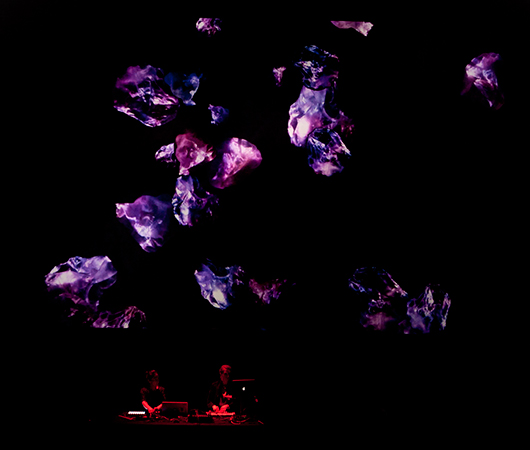
Getting Down, Biking Around, and Reveling in the Final Days of Trouw: Reflections on ADE 2014
Last week, XLR8R once again headed to The Netherlands to partake in the annual Amsterdam […]

Last week, XLR8R once again headed to The Netherlands to partake in the annual Amsterdam Dance Event, better known simply as ADE. This was our fourth year in attendance, and at this point, it’s difficult to explain just how big ADE has become. Unlike many of the events and festivals that XLR8R covers, ADE is not some niche event targeting a specific fragment of the electronic sphere. The Amsterdam Dance Event is a behemoth, an industry conference with a huge focus on the business of electronic music, which is why its daytime schedule offers up an extensive array of panels, workshops, lectures, and product demonstrations. (Meetings are also an essential piece of the puzzle, particularly for those looking to make deals and/or network.) Luckily for those in attendance, ADE also can be relied upon to present a wide variety of parties (something to the tune of 20 to 40 per night), a handful of which feature some pretty incredible line-ups. Over the course of five days and (very long) nights, we did our best to hit as many of these parties as possible, and jotted down a few notes along the way. Now that the festivities have come to a close, we wanted to share a few of our reflections after what proved to be a very intense week in Amsterdam.
Buraka Som Sistema at Paradiso (photo by Ali Mousavi)
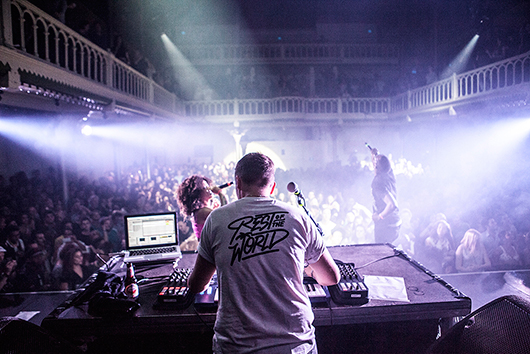
Buraka Som Sistema started things off right.
By the time we arrived in Amsterdam on Wednesday evening, the first night of ADE was already in full swing, which sent us immediately scrambling to join the fray. During a marathon event like ADE, the first performance that one sees is rarely that consequential, but when it’s a good one, it can help establish a tone for the week. As such, we were drawn to the party-starting sounds of Buraka Som Sistema. The Portuguese kuduro/global bass outfit may not appear on XLR8R as frequently as it once did—although the Buraka-affiliated Enchufada label often pops up on the site—but there’s little question that the long-running group still knows how to deliver in a live setting. Admittedly, the show’s 8:30 p.m. start time had us wondering how things would go, but our fears quickly melted away once we entered the absolutely rammed Paradiso theater, where a full-blown party was underway.
At this point, Buraka Som Sistema has transcended its club roots; the five-piece outfit is a essentially a festival act now, but the transition has been made without sacrificing too much of what made its music interesting in the first place. At ADE, the crowd ate up Buraka’s high-energy mix of big-room electro and techno with various African, Latin, and Caribbean rhythms. It’s not the most nuanced of sounds, but it’s certainly effective and a whole lot of fun, especially when delivered with one of the group’s producers (DJ Riot) perched behind a full drumkit and Buraka’s three MCs regularly hyping the crowd. Songs from 2008’s Black Diamond, such as “Sound of Kuduro” and “Kalemba (Wegue Wegue),” undoubtedly elicited the wildest responses, but with Buraka periodically inviting members of the crowd on stage (at one point, something like 100 girls were dancing alongside the group), firing confetti canons, and engaging the audience with call-and-response refrains, the energy rarely dipped during the rest of the set. Some of the performance was a bit silly, of course, yet Buraka is one of the few electronic acts that can incorporate crowd-revving antics and actual showmanship without seeming gauche or overly tacky. Without question, the group is all about bringing the party, but it’s not a party that anyone would or should be embarrassed to attend. And with multiple nights of serious, heads-down DJ sets ahead of us, starting off our ADE experience with a real show proved to be a great decision.
Buraka Som Sistema at Paradiso (photo by Ali Mousavi)
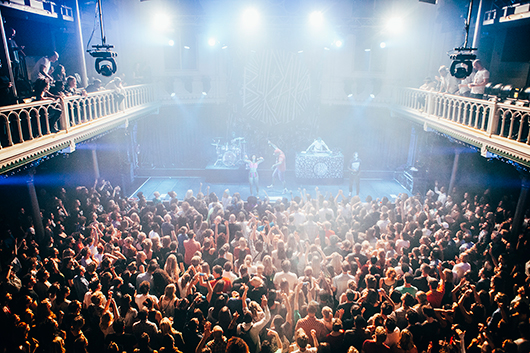
It quickly became apparent that seeing everything we wanted to see would be impossible.
Although it seems crazy now, there was once a time when XLR8R used to decline ADE’s invitations. At recently as five years ago, the conference, which began in 1996, was more rooted in the commercial end of dance music, and we simply didn’t feel like there were enough XLR8R-relevant artists participating to warrant a trip to Amsterdam. Nowadays, things have changed. While ADE’s core is undoubtedly still based around more commercial sounds and shows (more on that later), its organizers have effectively expanded the event in recent years to include more credible acts, labels, and promoters. In all honesty, it sometimes feels like ADE has even gone too far to cater to the tastemaker crowd; not because it’s a bad thing to see so many credible artists on the bill, but because it’s questionable whether or not there’s enough of an audience for these acts to support five or more events in a single night. Granted, it’s odd to be taking issue with ADE presenting too many opportunities to watch great music, but it’s also interesting that the growth of the “underground” has been paralleled by a sharp decline in “we’re all in this together” camaraderie, especially amongst promoters. At ADE, this has manifested in the simple reality that on some nights, there were simply too many good shows happening simultaneously that targeted the same audience.
As such, going out each night required a lot of planning, at least for those who hoped to see even a fraction of the artists on their agenda. Things were particularly difficult on Thursday, where Trouw had a Colours vs. Clone Records night with Hessle Audio, Midland, Leon Vynehall, and more; Dekmantel took over the North Sea Jazz Club with Boddika, Surgeon, Juju & Jordash, and Joey Anderson; Ninja Tune presented a showcase at OT301 with Actress, Martyn & copeland, Seven Davis Jr., and Moire; Melkweg was taken over by Modeselektor, which presented a Modeselektion night with L-Vis 1990, Dark Sky, Henrik Schwarz, Nosaj Thing, Akkord, Schlachthofbronx, and others; Surefire staged its showcase at Sugar Factory with Appleblim, Livity Sound, Addison Groove, Peverelist, and Second Storey; Knekelhuis brought Hieroglyphic Being and Beau Wanzer to Radion; and the local Tape Records crew hosted Funkinevil, Marcellus Pittman, and Mark Du Mosch at Tolhuistin. And those were just the shows we considered attending that night, as numerous others had at least an artist or two who we found interesting and would have been happy to see under different circumstances.
Things did mellow out a bit on Friday and Saturday, when several venues shifted their sights towards more commercial sounds, but there was never a point where we felt like there wasn’t something going on that we wanted to see. While this occasionally required making some tough choices—and ultimately missing a ton of acts that we had wanted to check out—we do recognize that this is something that many would consider to be a “good” problem for ADE attendees.
Addison Groove at Sugar Factory (photo by Eva de Korte)
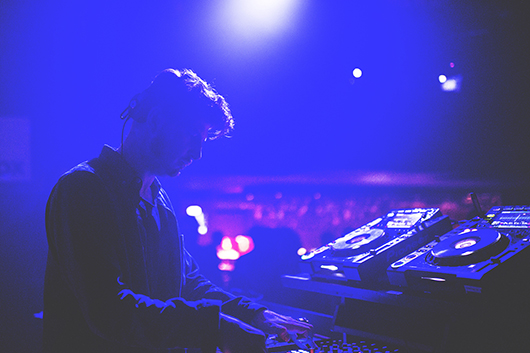
As a host city, Amsterdam has few drawbacks.
We’ve commented on this in previous years, but when it comes to cuteness, Amsterdam is just about impossible to beat. With its distinct architecture, canals, and general air of pleasantness, Amsterdam is a wonderful place to explore, particularly on a bicycle. (In all honesty, having a bicycle is pretty much essential to the Amsterdam experience, and the city caters to that reality with an extensive series of bike lanes and a general deference to cyclists that only exists in a few places on Earth. As such, renting a bicycle was something we did within the first few hours of getting to town.) Beyond that, it’s clean, people are friendly, everyone speaks English, and the overall vibe is a relaxed one. Obviously, Amsterdam isn’t perfect—it’s an expensive place, the food (with a few notable exceptions) is often mediocre at best, and cloudy/rainy days are pretty much the norm, but on the whole, someone would be hard pressed to truly have a bad time in the city.
More specific to ADE, Amsterdam also earns high marks as a clubbing destination. The mere fact that the city is able to accommodate hundreds of thousands of partiers during ADE is impressive in its own right, particularly when one considers how many venues are required, not to mention all the equipment and staff needed to keep them running. Having observed the ADE cycle for several years now, it’s become clear that electronic music is a genuine industry here, and seems to be respected as a viable part of the economy. While the city’s laid-back atmosphere creates an environment in which people are allowed, and even encouraged, to party, Amsterdam takes things a step further during ADE, and actually facilitates this extra wave of late-night activity. It’s a refreshing attitude, and one that a lot of other cities could learn from.
Paula Temple and Jem the Misfit at EYE (photo by Tania Gualeni)
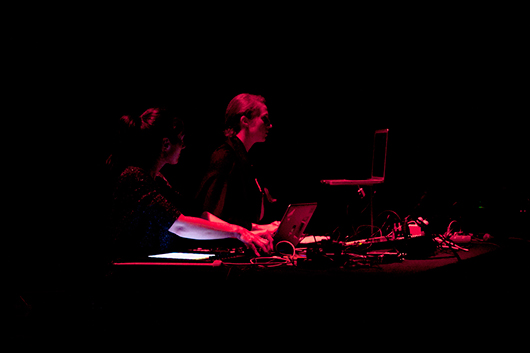
Paula Temple seriously caught our attention.
Over the past few years, we’ve periodically reported on the music of Paula Temple, but ADE was XLR8R‘s first chance to see her perform. The Berlin-based British producer and R&S affiliate actually appeared at a number of different ADE events, but the one we caught was Friday’s Nonagon, a special collaborative audio-visual performance with Jem the Misfit at a theater in the EYE (The Netherlands’ national museum for film), which resides in an absolutely stunning building right on the harbor. Impressive setting aside, we still weren’t sure how Temple’s noisy techno excursions would fare in a seated theater, but our concerns ultimately proved to be fruitless—the set was one of the most compelling things we witnessed all week.
Jem the Misfit’s visuals, which placed a heavy focus on close-up shots of unique stones/crystals and oddly compelling imagery of things like butter melting, were vibrant and undeniably potent, while Temple’s music did the rest of the work. Performing beneath the theater’s enormous screen (with Jem the Misfit right alongside her), Temple’s set was very strong, even as she moved between distortion-laced dirge and pounding techno assaults. A few tracks did include relatively pop vocal refrains, but Temple’s moody beat constructions helped to maintain a stark and foreboding vibe. The system could have been louder and a bit more consistent, as the volume seemed to drop about halfway through the set, but the experience of being in the theater was a rewarding one nonetheless. And given that much of the music on offer was newly created especially for the show, we eventually left thinking that Temple is someone we’ll need to keep a close eye on in the months ahead. She’s released some excellent music already, but it seems like her best is yet to come.
4DSOUND at Compagnietheater (photo by Georg Schroll)
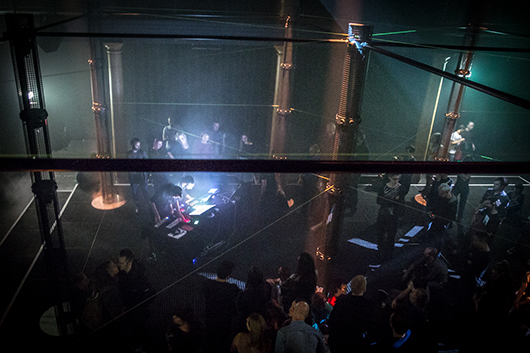
We didn’t entirely understand how 4DSOUND worked, but it definitely sounded great.
In the weeks leading up to ADE, checking out the 4DSOUND system was one of the few things we knew that we had to do during our time in Amsterdam. Honestly, we weren’t exactly sure how the system worked or why it was being touted as an impressive new innovation, but the project—and the artists involved—seemed interesting enough to warrant our attention. On Thursday, 4DSOUND had partnered with the Raster-Noton label for a special ADE showcase at Compagnietheater, where the system was being housed all week. We arrived in time for the night’s first performance, a collaborative session from Robert Lippok and Peter Kirn, who sought to “produce a live structure in sound, space, and rhythm, composing on the basis of designed spaces by architects Arno Brandlhuber, Matteo Ferroni, and Jason Danziger commissioned specifically for this project.”
While this may sound like the usual sort of empty promo-speak, the idea of creating a music-based “structure” is actually something that’s feasible with 4DSOUND. The system resided within a sort of metal lattice, which filled up the majority of the room, and while its sleek design certainly looked cool, it also enabled users to program sounds to specific locations in the space. (For instance, a hi-hat sound could be programmed to only be emitted from speakers in a particular corner of the room.) It’s difficult to explain the effect in words, but when used properly, it allows artists to create a rich, constantly moving and evolving piece that not only sounds amazing, but also comes much closer to what sounds are like in the real world. Lippok’s and Kirn’s set, which nicely combined pensive washes of noise and distortion with light, floating melodies, was a completely immersive experience, one that sounded different depending on exactly where the listener sat in the room. (Walking around during the performance further added to the novelty, as the sounds being presented would change and evolve with each step.) Unfortunately, 4DSOUND is such an enormous (and expensive) undertaking that it likely won’t be widely implemented anytime soon—it also doesn’t help that most artists don’t really have the technical know-how to utilize the system properly—but it still offered something a cut above the average sound-art experience.
Robert Lippok and Peter Kirn at 4DSOUND at Compagnietheater (photo by Georg Schroll)
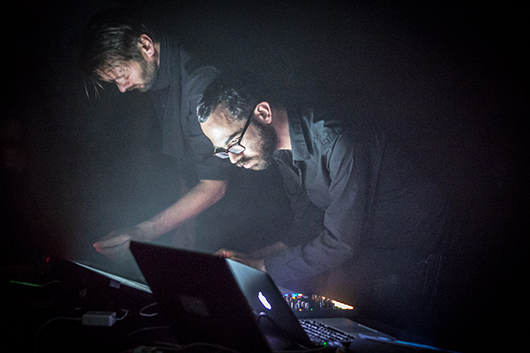
4DSOUND at Compagnietheater (photo by Georg Schroll)
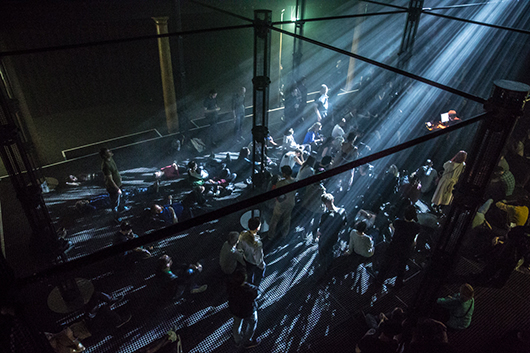
Dekmantel made the best of a bad situation.
Over the past few months, the local Dekmantel crew—which is responsible for the excellent festival of the same name—once again rolled out an impressive series of ADE parties, with four nights of absolutely stacked line-ups. Unfortunately, about a month before the conference began, the venue which Dekmantel had booked—the MC Theater, a place we admittedly haven’t loved in the past—went into bankruptcy. As a result, instead of having a two-room, 1700-person capacity venue at their disposal, Dekmantel’s organizers were left with the 550-person capacity North Sea Jazz Club, which sits right next door to the MC Theater. Going forward with the shows meant taking a huge loss during ADE, but Dekmantel still elected to move forward with downsized versions of its events, largely in an effort to not suddenly cancel on the dozens of acts that had been booked. It was an admirable decision, but it that made getting into the Dekmantel events all but impossible for anyone that hadn’t bought a presale ticket.
In the end, we only managed to make it to a Dekmantel party on Thursday, where we caught a typically quality set from New Jersey house explorer Joey Anderson, and an absolutely stellar live session from Amsterdam-based duo Juju & Jordash. Granted, the pair always impresses with its improvisational approach and obvious mastery of its gear, but Thursday night found the group performing at an hour (1 a.m. to 2 a.m.) when keeping the dancefloor moving was an absolutely necessity. As such, the duo played harder than we’ve been accustomed to seeing, and while we always enjoy the psychedelic tendrils of Juju & Jordash’s music, this more direct and booming approach really sounded excellent. It wasn’t quite techno, but it definitely had a raw feel and plenty of low-end punch that we didn’t expect. We would never advocate for any act to change its sound, but it was definitely nice to see that Juju & Jordash were fully capable of turning up the heat.
Livity Sound at Sugar Factory (photo by Eva de Korte)
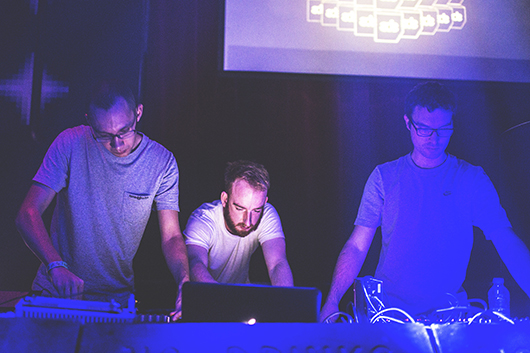
Crème Organization and L.I.E.S. might have thrown the week’s best party.
On Friday night, Dutch imprint Crème Organization and NYC outpost L.I.E.S. joined forces at Studio 80, a venue which generally books quality acts but unfortunately sits right in the most touristy part of central Amsterdam. As such, the crowd was something of an unusual mix, with dudes in Hollister t-shirts bro-ing out next to awkwardly fashionable vinyl diehards. The club was completely packed, its dark and humid confines not offering much in the way of chillout space, but somehow, the party still worked, probably because of the uniformly excellent music on offer. By the time we arrived, Miami’s Greg Beato was wrapping up his set with quality slices of unpolished electro in the main room, while Steve Summers presented a live set of more chugging techno sounds in the smaller back room. He would eventually give away to Randomer, the only British member of the L.I.E.S. cadre, whose set nimbly combined hard-edged, distorted techno with a distinctly UK sensibility; his occasional forays into unusual rhythms and percussion patterns (think Hessle Audio) were a welcome change of pace.
Still, the night’s brightest moments belonged to the Dutch, namely Legowelt and Crème Organization boss TLR. The former played live, serving up a compelling, synth-soaked brew of house and techno that simultaneously referenced both ’90s Detroit and 16-bit videogame soundtracks. It was excellent stuff, but TLR was even better, with a DJ set that nimbly moved between genres but spiced things up with plenty of propulsive electro. With daybreak rapidly approaching, TLR eventually gave way to young artist Innershades, who deftly maintained the party vibe. It’s safe to assume that the dancefloor kept jumping well into Saturday morning, but an intense need to sleep eventually sent us toward the door sometime after 6 a.m.
DVS1 at Gashouder (photo via Awakenings)
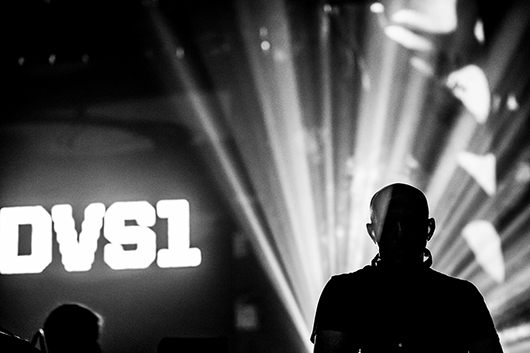
Good line-ups didn’t always means good parties.
On Saturday night, we elected to start our night at the Electric Deluxe showcase, as we were enticed by the fact that Lucy and DVS1 would be kicking off the festivities. Furthermore, after a week in which we had seen a lot of house, checking out a proper techno event seemed like a good change of pace. The party was happening at Gashouder, which we saw was located in a park on the western end of the city (where a number of other venues also reside), so we hopped on our bike and trekked across town. However, even before we walked into the venue, it was clear that we had made a mistake, as Gashouder turned out to be a 5000-person capacity, arena-like venue that had been decked out in the same manner that one would expect a corporate American “rave” event to be. The audience was young, glowsticks were in the air, the venue had a designated massage zone and a mini food court, and we were even forced to place our coat into a tiny locker—at a cost of six (!) euros. Despite all of that, the music was fine, as both Lucy and DVS1 (the only acts we stuck around to see, although the rest of the bill included Nina Kraviz, AnD, Speedy J, and others) played well, but in that context, their selections really lost all meaning. These kinds of massive parties are almost entirely divorced from underground club culture, so when we were actually at one, we found it hard not to fixate on just how much of the electronic music industry is purely focused on making money and maximizing profits. Walking around the party, we came across several industry professionals, and the few positive comments that they could muster were generally in reference to the high quality of the event production; of course, that was all well and good, but those observations essentially sidestepped the fact that these kinds of large-scale events are essentially devoid of any soul, not to mention a quality vibe for people in search of more than glossy visuals and a lazer show.
In truth, we’re not trying to pick on the Electric Deluxe event—it just happened to be the only party of this kind that we happened to attend, and our presence was basically an accident that could have been avoided with a bit more research. On the one hand, that speaks to how diverse ADE has become, as it’s absolutely possible to attend the conference and only go to high-quality events in cool spaces curated by legitimate music fans. On the other, it was a good reminder of exactly what ADE is and always has been. There may be a festival element to the Amsterdam Dance Event, but this is very much an industry event, something which is put on by mechanical rights organizations (the people who collect royalties, publishing, etc.) in The Netherlands. Even with all the parties on offer, ADE is an event that caters to and is designed for people who want to do business, which means that many of those in attendance are agents, managers, bookers, festival organizers, promoters, label representatives, gear representatives, and other folks whose primary interest is making money. That’s not an implicitly bad thing—after all, journalists are also part of the ADE equation, and few of us are working for free—but it does color the tone of the proceedings. ADE is what it is, and that shouldn’t be glossed over, not matter how many credible artists get booked.
Lucy at Gashouder (photo via Awakenings)
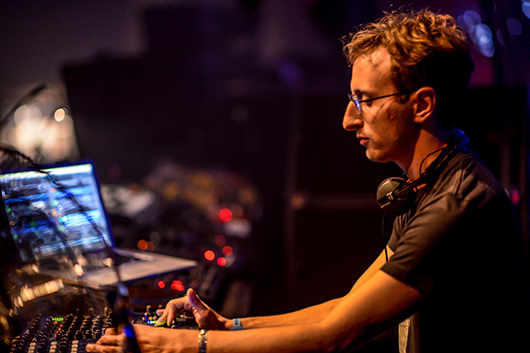
Trouw is going to be missed.
Speaking of reiteration, no XLR8R review of ADE would be complete without a few paragraphs of gushing about the greatness of Trouw. At this point, there’s no question that it’s the best club in Amsterdam, and most people seem to agree that it’s one of the best clubs in the world, which is why it’s so disappointing that the place will be closing for good in early 2015. As such, this was Trouw’s last ADE, and the club unsurprisingly made it count with a stellar series of parties hosted by the likes of Rush Hour, Colours, Clone, Hessle Audio, Resident Advisor, and others, all of which featured some top-notch talent, both from Amsterdam’s local scene and from further afield. Throughout the week, the atmosphere at Trouw was a joyous one, and the impressive sets were simply too numerous to list. Still, a few especially serendipitous moments did take place, such as Thursday night’s epic back-to-back session in the main room, which included the likes of Ben UFO, Pangaea, Pearson Sound, Leon Vynehall, Serge, Jackmaster, Midland, and Cinnaman trading off records—and getting a bit nostalgic with their selections—during the party’s final few hours.
Still, it was Sunday, the final day of Trouw’s ADE run, that proved to be the most memorable. Granted, these ADE closing parties are always special at Trouw, as both the staff and the crowd shed their collective stresses from the week and truly let loose. Furthermore, the club decided to do something special and opened a third room for just one night. (Dubbed De Natte Cel, it once served as a bathroom deep inside the massive building.) Covered in tiles and almost immediately dripping with precipitation, the room was an excellent addition to the day’s festivities, which began at 8 a.m. on Sunday and ran straight through until Monday morning. Sunday’s performances were also notably good, as Solar was unexpectedly tasked for a five-plus hour set in the afternoon when Omar-S‘ plane was delayed, prompting the San Francisco DJ to deliver a top-flight journey through house, techno, electro, new wave, and industrial as the dancefloor gradually came to a boil throughout the afternoon. He eventually turned things over to Gerd Janson, a Trouw regular who lived up to his esteemed reputation with a set of high-energy house and disco that had the main room going wild. As the night wore on, Tom Trago, Talaboman, Mano Le Tough, and Job Jobse stepped in, while many of the club’s residents—including Trouw founder Olaf Boswijk—kept things humming in the basement downstairs. Over in De Natte Cel, Omar-S finally got on the decks, as did longtime Trouw favorite Traxx and a collection of Rush Hour all-stars. Even as the hour grew late (or early, depending on one’s perspective), the club stayed incredibly full and smiles were in abundance. Everyone knew that this was the last time there would be a Trouw party during ADE, and we all wanted to celebrate.

